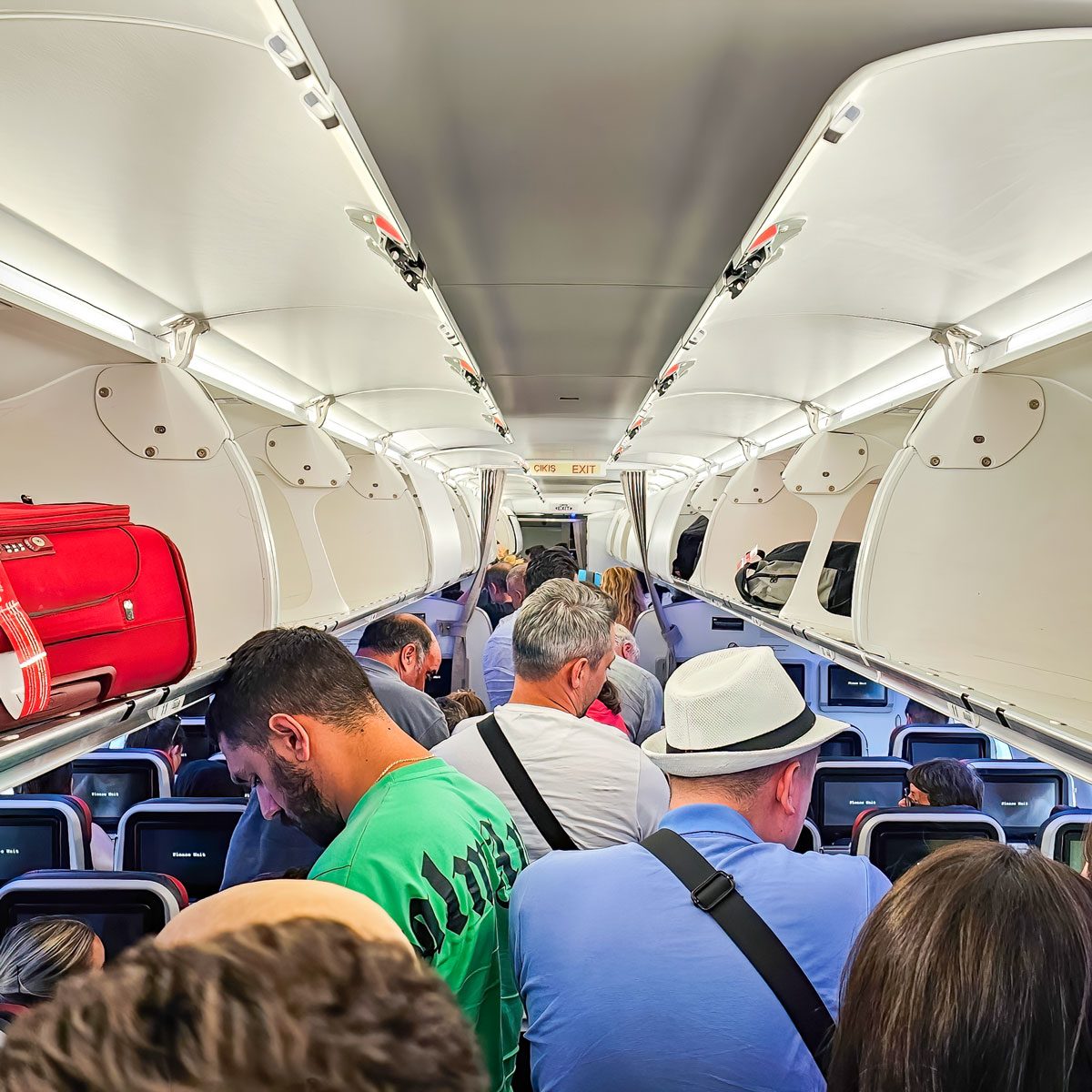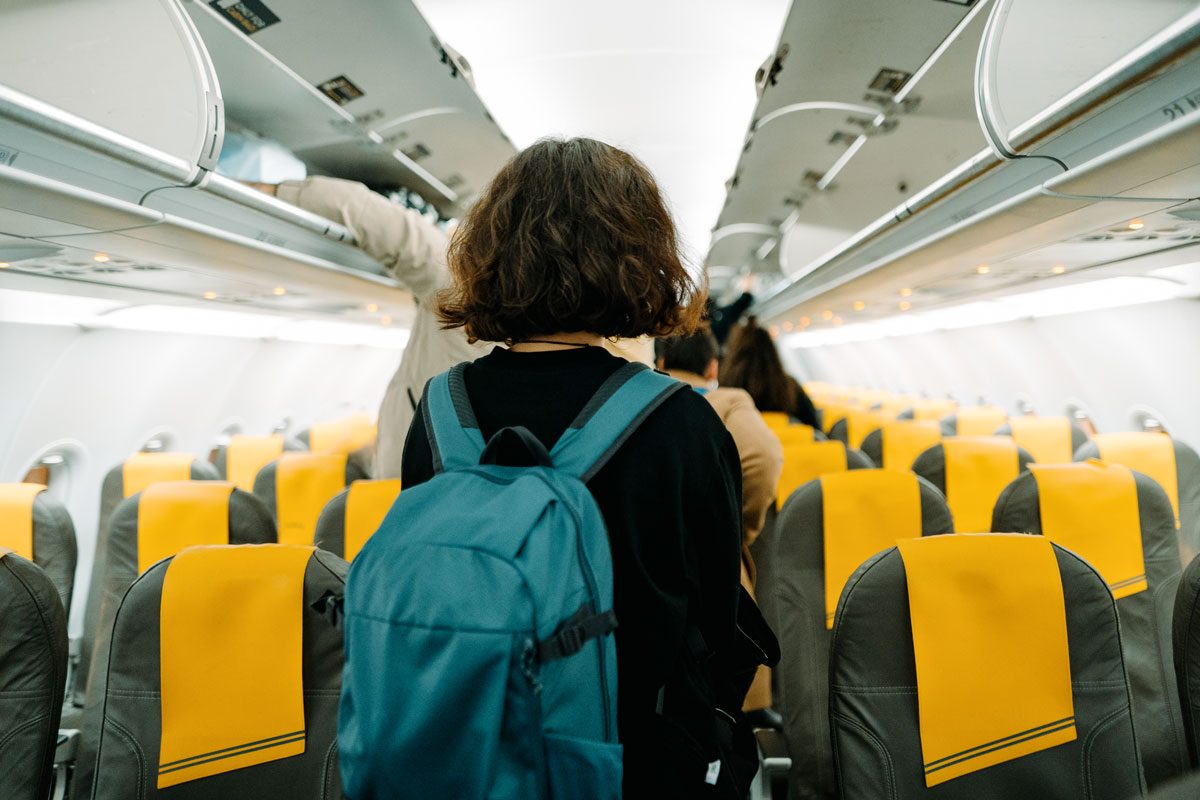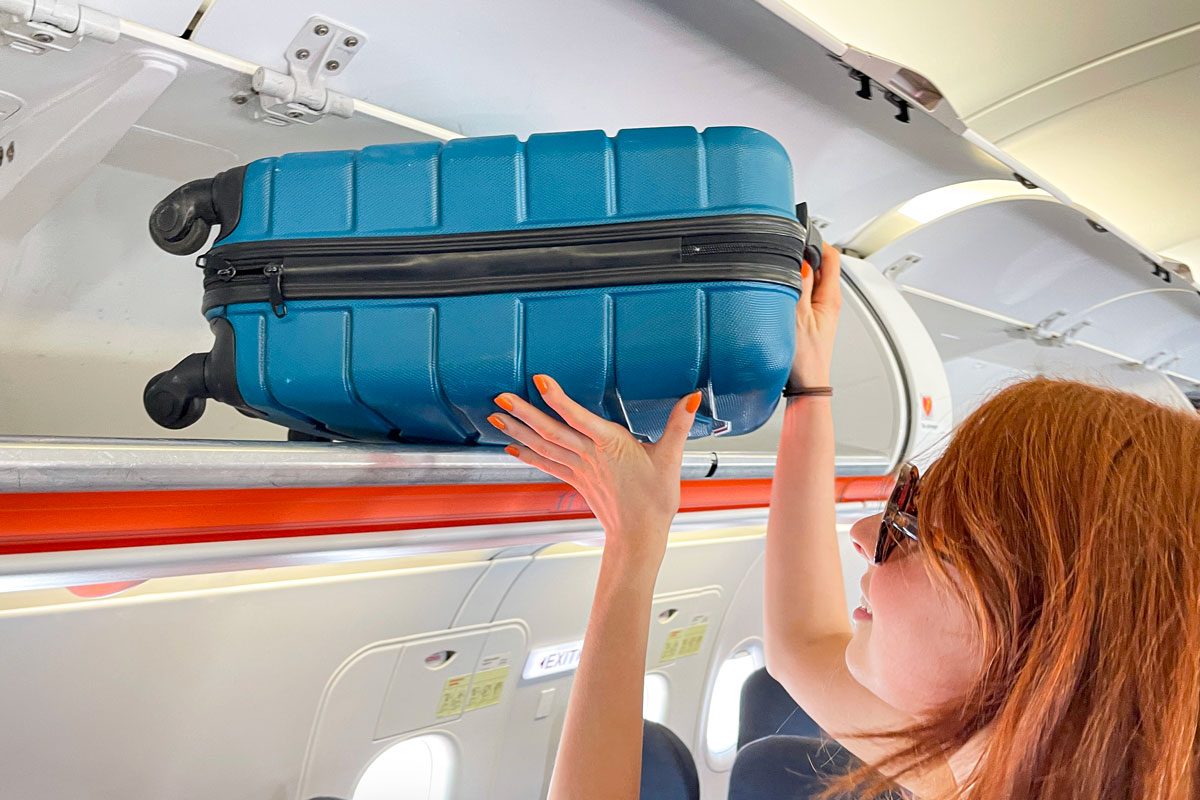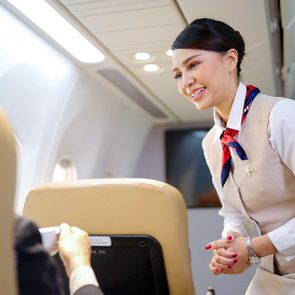These pests are making air travel more frustrating than ever. Are you one of them?

Here’s What You Need to Know About “Aisle Lice” Before Your Next Flight

Getting to your destination can be a combination of excitement, impatience and sheer panic—or at least it can be when you’re not sure you’ll make your connecting flight. That’s the situation I found myself in when heading on a bucket-list trip to Antarctica. My flight from Los Angeles kept getting delayed, and while I’d originally had more than two hours to make my connection to Buenos Aires, that was shrinking by the minute. I needed to get off the plane fast to make it—as did at least four other people on board—but the “aisle lice” who started crowding the plane’s aisles once we landed were making that very difficult.
No, aisle lice is not the nicest term, but it’s accurate. These plane pests immediately clog the aisles and ignore flight attendants’ reasonable requests for passengers to remain in their seats so those with tight connections can deplane first. It seems like basic airplane etiquette, but this polite gesture often gets ignored. You might have even been guilty of broaching it upon occasion, especially after a long flight. (Come on, fess up!)
So what’s the deal with these passengers, and what are airlines doing about this problem? I spoke to two flight attendants to get the inside scoop on aisle lice and learn what you can do if you need to get off a plane quickly. Read on to learn the do’s and don’ts of deboarding before your next flight.
Get Reader’s Digest’s Read Up newsletter for more travel, tech, cleaning, humor and fun facts all week long.
Why are “aisle lice” such a problem?

This scramble to be first in the aisle and, ideally, off the plane isn’t just an annoyance—though as Reddit posts attest, it’s super annoying. But it also slows everything down.
Airlines have a method to the madness when it comes to unloading a plane: Passengers are supposed to deplane row by row in an orderly fashion. (Though there’s no law that states you have to remain seated once the fasten-seat-belt light goes off.) But when people jump up the second the plane lands, they create a bottleneck, preventing those who actually need to exit quickly from getting through.
I’ve watched passengers who aren’t even in a rush block the way, leisurely collecting their overhead bags while others helplessly wait. It’s an even bigger holdup when passengers place their bags in an overhead compartment that’s not directly above their seat, according to Charles, a flight attendant with more than 25 years of experience.
Heather Poole, another veteran flight attendant and the author of the book Cruising Altitude: Tales of Crashpads, Crew Drama, and Crazy Passengers at 35,000 Feet, agrees. “It’s one thing to stand up and wait patiently to disembark,” she says, “and another thing to impatiently push people out of the way to get a bag out of a bin that isn’t close to their seat.”
Inefficiency aside, it’s just bad etiquette.
Why do passengers crowd the aisle like this?
While there definitely seems to be an entitlement issue at play here, not to mention a sense of narcissism, we’ll be kind and acknowledge that this rude behavior mostly stems from stress. People want to get off the plane to stretch their legs, maybe rush off to the bathroom or a coffee stand, and—in the most understandable cases—make a connecting flight. In that last situation, if you don’t get off the plane, you might miss your next flight, and the rest of your trip could be derailed.
Of course, the irony is that when you do this, you’re likely making things worse. One person stands up, and then another person worries that they should be doing the same thing to avoid problems, and so on. It’s kind of like FOMO, but instead of a fear of missing out, it’s the fear of missing the opportunity to get an edge on the competition. In the end, it’s a cascading effect and a no-win situation. After all, the more people clog the aisle, the slower the actual deboarding will be … and the higher the likelihood that you’ll miss your connecting flight or simply move on to the next phase of your trip.
What are airlines doing to combat this problem?
While some airlines have started taking steps to manage gate lice—a similar phenomenon where people crowd the gate before boarding—there hasn’t been any progress on the aisle-lice issue. Some airlines have considered structured deplaning, similar to group boarding, but there are issues separating passengers traveling together but not sitting together; it also doesn’t work well for families or people with accessibility issues.
Flight attendants sometimes use humor to encourage better behavior. Southwest, for example, is known for playful announcements reminding passengers to let those with tight connections off first. But often, people don’t listen, and enforcement is tricky. With no real consequences for rushing the aisle, many travelers do it anyway.
What’s the right thing to do when the plane lands?
For starters, be prepared before the seatbelt sign turns off. “I’d rather see passengers ready to disembark than passengers sitting in their seats waiting to be the last person off the plane,” says Poole. “Those are the people who don’t put on their shoes until the plane is completely empty and then spend extra time checking and rechecking seat-back pockets and overhead bins while the crew is standing nearby waiting for them to leave.”
When it is time to get off the plane, be aware of your surroundings, follow the natural flow of deplaning (wait for your row’s turn!) and make sure you’re ready to go without blocking others.
What should you do if you need to get off the plane quickly?

Sometimes, you really do need to move fast. Whether you have a tight connection or another urgent reason to disembark, here’s what you can do to improve your chances of making it out first.
Give yourself enough breathing room when you book
If you have a connecting flight, think way ahead—when you’re booking. Both flight attendants we spoke with say this is the most important thing passengers can do so they’re not panicking while waiting to deboard.
“If you have a connecting flight, always try to book an hour to an hour and a half or more between flights because delays and mechanicals happen,” Poole says. “It’s better to have a booked seat on a flight that you have to sit and wait for than to end up on a standby list, possibly not making it to your final destination because you booked a tight connection and missed your flight.”
Choose your seat wisely
If you have a connecting flight, you may also want to think about choosing the best seat on the plane for that purpose. “If you need to get off quickly, spend the extra money to book a seat close to the front of the cabin,” suggests Poole. This way, you’ll be among the first passengers to deplane instead of waiting for an entire section to clear out ahead of you.
Keep your luggage within reach
If you know you’ll need to exit quickly, bring carry-on luggage that fits under the seat in front of you. That way, you won’t have to fight against the flow of traffic when it’s time to grab your bag. The faster you can collect your belongings, the quicker you can get off the plane.
“People, in general, overpack their luggage,” adds Charles. “Imagine how much quicker boarding and deplaning would be if everyone scaled down what they bring.”
Talk to a flight attendant
When you board or while you’re in the air, let the flight attendant know if you have an issue like a tight connection. They will do their best to help you get off the plane quickly so you can rush off to your next flight. “Crew can ask passengers to remain seated so connecting passengers can deplane first,” says Poole. “Connecting passengers [often] don’t realize just how many others are connecting.”
Translation: You’re not the only one who may have an issue, so this can take a little coordination and planning.
The bottom line
Unfortunately, aisle lice likely aren’t going away anytime soon, but you can do your part to not make the problem worse. Awareness and consideration can go a long way in making air travel smoother for everyone. So the next time you land, take a moment before jumping up. If you’re not in a rush, staying seated for an extra minute just might help someone else make it to their next adventure—and help you get off the plane faster.
Why trust us
Reader’s Digest has published hundreds of travel stories that help readers explore the world safely, easily and affordably. We regularly cover topics such as the best places to visit (and the best times to visit them), tips and tricks to zoom through airport security, flight-attendant secrets, hotel-room hacks and more. We’re committed to producing high-quality content by writers with expertise and experience in their field in consultation with relevant, qualified experts. We rely on reputable primary sources, including government and professional organizations and academic institutions as well as our writers’ personal experiences where appropriate. For this story on aisle lice, Lisa Niver tapped her experience as a longtime travel journalist who has visited 102 countries on six continents to ensure all information is accurate. We verify all facts and data, back them with credible sourcing and revisit them over time to ensure they remain accurate and up to date. Read more about our team, our contributors and our editorial policies.
Sources:
- Heather Poole, veteran flight attendant and the author of the book Cruising Altitude: Tales of Crashpads, Crew Drama, and Crazy Passengers at 35,000 Feet; email interview, February 2025
- Charles, flight attendant; email interview, February 2025
- New York Post: “‘Aisle lice’ is latest air travel annoyance to spark social media debate”
- Reddit: “Who do hate more? Gate lice or aisle lice?”
- Reddit: “Please remain seated”
- Cornell Law School: “14 CFR § 121.311 – Seats, safety belts, and shoulder harnesses”























